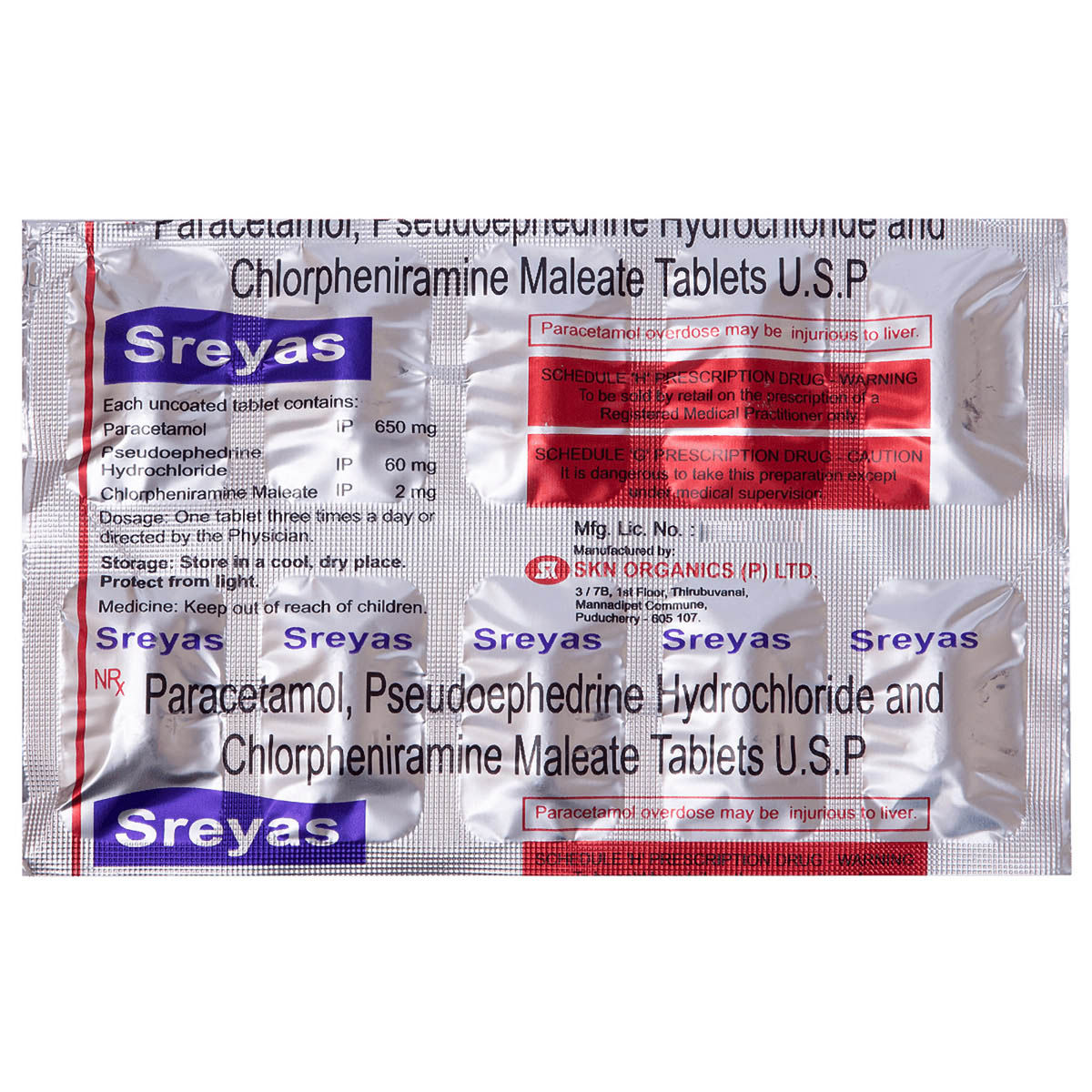Paracetamol+pseudoephedrine+chlorpheniramine
About Paracetamol+pseudoephedrine+chlorpheniramine
Chlorpheniramine+paracetamol+pseudoephedrine belongs to the class of medication called 'cough and cold medications' primarily used to treat symptoms of the common cold and allergies like sneezing, runny/stuffy nose, fever, headache, body pains, congestion or watery eyes. The common cold is a respiratory illness affecting the nose and throat. It is mostly caused by viruses known as 'rhinovirus'. The virus enters the body through the nose, mouth or eyes and spreads easily through droplets in the air when the person who is sick sneezes, coughs or talks.
Chlorpheniramine+paracetamol+pseudoephedrine is a combination medicine that contains Paracetamol (mild analgesic and antipyretic), Pseudoephedrine (decongestant), and Chlorpheniramine (antihistamine/antiallergic). Paracetamol is an analgesic (relieves pain) and antipyretic (reduces fever) that works by blocking the production of certain chemical messengers in the brain known as prostaglandins responsible for pain and fever. Pseudoephedrine is a decongestant that works by contracting and narrowing the small blood vessels of nasal passages and airways, relieving congestion or stuffiness in the nose. Chlorpheniramine belongs to the class of antihistamines (anti-allergic drugs) that works by blocking the action of histamine, a substance responsible for causing allergic reactions. It helps relieve allergy symptoms such as sneezing, running nose, watery eyes, itching, swelling and nasal congestion.
Take Chlorpheniramine+paracetamol+pseudoephedrine as prescribed by your doctor. Your doctor will recommend how often you take Chlorpheniramine+paracetamol+pseudoephedrine based on your medical condition. Some people may experience nausea, sleepiness, allergic reaction, dizziness, headache, restlessness, nervousness and insomnia (difficulty sleeping). Most of these side effects of Chlorpheniramine+paracetamol+pseudoephedrine do not require medical attention and gradually resolve over time. However, if the side effects persist or worsen, please consult your doctor.
If you are allergic to Chlorpheniramine+paracetamol+pseudoephedrine or any other medicines, please tell your doctor. Please do not take more than the prescribed dose of Chlorpheniramine+paracetamol+pseudoephedrine as it may cause liver damage and can be lethal. If you have high blood pressure, diabetes, glaucoma, hyperthyroidism (overactive thyroid), kidney, liver, heart or urinary problems, inform your doctor before taking Chlorpheniramine+paracetamol+pseudoephedrine. If you are pregnant, it is advised to inform your doctor before using Chlorpheniramine+paracetamol+pseudoephedrine. Do not use Chlorpheniramine+paracetamol+pseudoephedrine in breastfeeding mothers without doctor’s advice as it may be excreted in breast milk and cause harm to the baby.
Uses of Paracetamol+pseudoephedrine+chlorpheniramine
Medicinal Benefits
Chlorpheniramine+paracetamol+pseudoephedrine belongs to the class of medication called 'cough and cold medications' primarily used to treat symptoms of the common cold and allergies like sneezing, runny/stuffy nose, fever, headache, body pains, congestion or watery eyes. Paracetamol is an analgesic (relieves pain) and antipyretic (reduces fever) that works by blocking the production of certain chemical messengers in the brain known as prostaglandins responsible for pain and fever. Pseudoephedrine is a decongestant that works by contracting and narrowing the small blood vessels of nasal passages and airways, relieving congestion or stuffiness in the nose. Chlorpheniramine belongs to the class of antihistamines (anti-allergic drugs) that works by blocking the action of histamine, a substance responsible for causing allergic reactions. It helps relieve allergy symptoms such as sneezing, running nose, watery eyes, itching, swelling and nasal congestion.
Directions for Use
Storage
Side Effects of Paracetamol+pseudoephedrine+chlorpheniramine
- Nausea
- Allergic reaction
- Dizziness
- Headache
- Restlessness
- Nervousness
- Insomnia (difficulty in sleeping).
Drug Warnings
If you are allergic to Chlorpheniramine+paracetamol+pseudoephedrine or any other medicines, please tell your doctor. If you are pregnant, it is advised to inform your doctor before using Chlorpheniramine+paracetamol+pseudoephedrine. Do not use Chlorpheniramine+paracetamol+pseudoephedrine in breastfeeding mothers without a doctor’s advice as it may be excreted in breast milk and cause harm to the baby. Chlorpheniramine+paracetamol+pseudoephedrine is not recommended for children below 4 years. Please do not take more than the prescribed dose of Chlorpheniramine+paracetamol+pseudoephedrine as it may cause liver damage and can be lethal. If you have high blood pressure, diabetes, glaucoma, hyperthyroidism (overactive thyroid), chronic bronchitis, asthma, chronic obstructive pulmonary disease (COPD), blockage in stomach or intestines, enlarged prostate gland, pheochromocytoma (tumour in the adrenal glands), kidney, liver, heart or urinary problems, inform your doctor before taking Chlorpheniramine+paracetamol+pseudoephedrine.
Drug Interactions
Drug-Drug Interactions: Chlorpheniramine+paracetamol+pseudoephedrine may interact with antidepressants (duloxetine, escitalopram), sleeping agents (ramelteon), pain killers (ibuprofen), fits medicine (phenytoin, carbamazepine) and blood pressure-lowering pills (atenolol, propranolol).
Drug-Food Interactions: Avoid intake of Chlorpheniramine+paracetamol+pseudoephedrine with chocolate and caffeine-containing foods such as cocoa beans and tea leaves as they may increase the risk of severity of side effects. Avoid consumption of alcohol with Chlorpheniramine+paracetamol+pseudoephedrine as it may increase the risk of liver damage and cause increased drowsiness, dizziness, and difficulty in concentrating.
Drug-Disease Interactions: If you have high blood pressure, diabetes, glaucoma, hyperthyroidism (overactive thyroid), chronic bronchitis, asthma, chronic obstructive pulmonary disease (COPD), blockage in stomach or intestines, enlarged prostate gland, pheochromocytoma (tumour in the adrenal glands), kidney, liver, heart or urinary problems, inform your doctor before taking Chlorpheniramine+paracetamol+pseudoephedrine.
Drug-Drug Interactions Checker List:
Safety Advice

Alcohol
unsafeAvoid consumption of alcohol with Chlorpheniramine+paracetamol+pseudoephedrine as it may increase the risk of liver damage and cause increased drowsiness, dizziness or difficulty concentrating. Please consult your doctor before consuming alcohol with Chlorpheniramine+paracetamol+pseudoephedrine.

Pregnancy
cautionThe safety of Chlorpheniramine+paracetamol+pseudoephedrine in pregnant women is unknown. If you are pregnant, consult your doctor before taking Chlorpheniramine+paracetamol+pseudoephedrine. Your doctor prescribes this medicine if the benefits outweigh the risks.

Breast Feeding
cautionChlorpheniramine+paracetamol+pseudoephedrine may pass into breast milk and cause harm to your baby. Besides this, Chlorpheniramine+paracetamol+pseudoephedrine may also slow milk production, so it is better to contact your doctor before taking Chlorpheniramine+paracetamol+pseudoephedrine.

Driving
cautionChlorpheniramine+paracetamol+pseudoephedrine may cause blurred vision or impair thinking in some people. Therefore, drive only if you are alert after taking Chlorpheniramine+paracetamol+pseudoephedrine.

Liver
cautionChlorpheniramine+paracetamol+pseudoephedrine has paracetamol which may causes harm to the liver in doses more than the recommended dose. Take Chlorpheniramine+paracetamol+pseudoephedrine with caution, especially if you have a history of liver diseases/conditions. The dose may be adjusted by your doctor as required.

Kidney
cautionTake Chlorpheniramine+paracetamol+pseudoephedrine with caution, especially if you have a history of kidney diseases/conditions. The dose may be adjusted by your doctor as required.

Children
consult your doctorChlorpheniramine+paracetamol+pseudoephedrine is usually not recommended for children.
Habit Forming
Diet & Lifestyle Advise
- Wash your hands with soap and water regularly to prevent the spread of germs.
- To improve overall health, eat plenty of foods rich in good bacteria, like yoghurt.
- Drink plenty of fluids to avoid dehydration.
- Gargle with salt water for relief from sore throat.
- Avoid alcohol consumption with Chlorpheniramine+paracetamol+pseudoephedrine as it may cause tiredness, drowsiness, or lack of concentration.
Special Advise
- Do not give Chlorpheniramine+paracetamol+pseudoephedrine to children below four years of age.
- Do not take Chlorpheniramine+paracetamol+pseudoephedrine for longer than seven days in a row (for adults) and five days (for children over 4).
- If you have allergic skin reactions, such as skin redness or a rash that spreads and causes blistering and peeling, immediately contact a doctor.
- Patients with glaucoma or benign prostatic hyperplasia (BPH) should use the medicine with caution and consult your doctor if you face any problems while using Chlorpheniramine+paracetamol+pseudoephedrine.
Patients Concern
Disease/Condition Glossary
Common cold: The common cold is an infection caused by the virus, mainly known as ‘rhinoviruses’, affecting the nose and throat (upper respiratory tract). Children younger than 6 years are at the most significant risk of colds, but healthy adults can also be affected by having 2-3 colds annually. In most cases, cold symptoms are recovered within a week or ten days. However, symptoms might last longer in people who smoke or are exposed to allergens like pollutants, dust, etc. The common cold symptoms include sneezing, sore throat, cough, congestion, mild body pains, low fever, mild headache, unwell, and stuffy or runny nose. In some cases, the discharge from the nose may become thicker and yellow or green, which is not an indication of bacterial infection.
Allergies: These occur when foreign allergy-causing agents (allergens) attack and invade our body, thereby causing the release of histamines. This chemical messenger 'histamines' causes swelling, inflammation, redness, itchiness, and itchy/watery nose, throat and eyes. Allergies generally occur due to chemicals, air pollution, pet danders, dust, pollen hairs, seasonal allergies like hay fever etc.
FAQs
Chlorpheniramine+paracetamol+pseudoephedrine is used to treat symptoms of the common cold and allergies like sneezing, runny/stuffy nose, fever, headache, body pains, congestion or watery eyes.
Chlorpheniramine+paracetamol+pseudoephedrine contains Paracetamol, Pseudoephedrine, and Chlorpheniramine. Paracetamol is an analgesic (relieves pain) and antipyretic (reduces fever) that works by inhibiting the production of certain chemical messengers in the brain known as prostaglandins that are responsible for pain and fever. Pseudoephedrine is a decongestant that works by contracting and narrowing the blood vessels. Thereby, provides relief from congestion and decreases the mucus production. Chlorpheniramine is an antihistamine (anti-allergic drug) that works by blocking the action of histamine, a substance responsible for causing allergic reactions. It helps to provide relief from allergy symptoms such as sneezing, running nose, watery eyes, itching, swelling and congestion or stiffness.
Yes, Chlorpheniramine+paracetamol+pseudoephedrine may cause drowsiness. It is not necessary for everyone taking Chlorpheniramine+paracetamol+pseudoephedrine to experience this side effect. Therefore, avoid driving or operate heavy machinery if you feel drowsy after taking Chlorpheniramine+paracetamol+pseudoephedrine.
Yes, Chlorpheniramine+paracetamol+pseudoephedrine contains paracetamol which acts as a mild pain killer (analgesic) and fever reducer (antipyretic). It works by inhibiting the production of certain chemical messengers in the brain known as prostaglandins responsible for pain and fever.
No, you are not recommended to take Chlorpheniramine+paracetamol+pseudoephedrine with Cetirizine as co-administration of these two medicines may increase sedation and cause drowsiness, dizziness and difficulty concentrating. However, please consult a doctor before taking Chlorpheniramine+paracetamol+pseudoephedrine with other medicines.
Chlorpheniramine+paracetamol+pseudoephedrine contains Paracetamol. This medicine is known to produce harm to the liver, mainly in doses more than the recommended level. Also, avoid drinking alcohol while taking this Chlorpheniramine+paracetamol+pseudoephedrine, as it may further increase your risk of liver damage. Use of this Chlorpheniramine+paracetamol+pseudoephedrine should preferably be prevented in patients with underlying liver disease. Inform your doctor immediately if you observe any early signs and symptoms of liver damage. These symptoms may involve rash, fever, loss of appetite, vomiting, nausea, stomach pain, fatigue, yellow skin or eyes, dark urine and abnormal liver enzymes.
Do not use this medicine if you have taken an MAO inhibitor in the past 14 days. A dangerous drug interaction could occur. MAO inhibitors include isocarboxazid, linezolid, phenelzine, rasagiline, selegiline and tranylcypromine.
Chlorpheniramine+paracetamol+pseudoephedrine belongs to the class of medication called cough and cold medications primarily used to treat symptoms of the common cold and allergies like sneezing, runny/stuffy nose, fever, headache, body pains, congestion, or watery eyes.
Chlorpheniramine+paracetamol+pseudoephedrine is safe when used as prescribed by your doctor. However, it may cause side effects like nausea, sleepiness, allergic reaction, dizziness, headache, restlessness, nervousness, and insomnia (difficulty sleeping) while using it.
Chlorpheniramine+paracetamol+pseudoephedrine may cause nausea and vomiting. Take it with food to help prevent nausea. Avoid fried/fatty foods, drink enough fluids, and eat small, frequent meals to cope with vomiting. Consult the doctor if the condition persists.
Chlorpheniramine+paracetamol+pseudoephedrine may cause sleepiness or dizziness. To cope with sleepiness or dizziness, rest and avoid driving or heavy activities until the feeling passes. However, if these conditions persist or worsen consult your doctor immediately.
Taking more than the recommended dose of Chlorpheniramine+paracetamol+pseudoephedrine can be harmful. It's essential to follow the prescribed dosage to avoid potential side effects like nausea, vomiting, abdominal pain, dizziness, allergic skin reactions (most commonly redness and itching), hallucinations, sweating, and malaise.
Do not use Chlorpheniramine+paracetamol+pseudoephedrine if you are allergic to any of its components and do not give Chlorpheniramine+paracetamol+pseudoephedrine to children below four years of age.
Chlorpheniramine+paracetamol+pseudoephedrine should be stored in a cool and dry place away from sunlight. Keep its reach away from children.
The common side of Chlorpheniramine+paracetamol+pseudoephedrine may include nausea, sleepiness, allergic reaction, dizziness, headache, restlessness, nervousness, and insomnia (difficulty sleeping). Most of these side effects of Chlorpheniramine+paracetamol+pseudoephedrine do not require medical attention and gradually resolve over time. However, if the side effects persist or worsen, please consult your doctor.





